Neighborhood Hawks Part II:
Beyond the Backyard
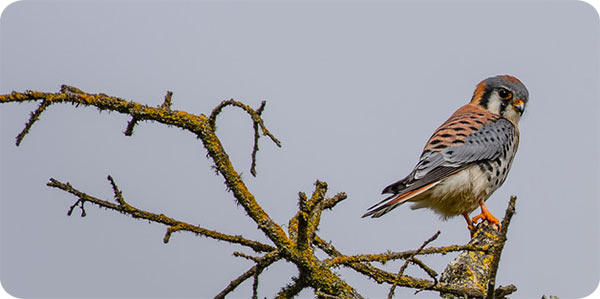
American Kestrel - Local photo by Larry Scheibel
Last month, we covered the common backyard hawks of the Bay Area – the daytime birds of prey you are most likely to see around your yard and typical residential areas. And those birds – the red-tailed hawk, red-shouldered hawk, Cooper’s hawk, sharp-shinned hawk, and turkey vulture – are among our more common raptors generally, whom you will often see soaring overhead or shooting out of the trees when out in natural areas as well. This month, we’re covering another handful of local hawks: those which are unlikely to venture in amongst the houses and bustling humans, but which you can find in appropriate habitats within our larger North Bay “neighborhood.”
Fairly common...in the right place
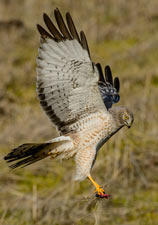 Northern Harrier: This bird was formerly known as the marsh hawk, a name which gives a good clue to its preferred habitat. They are fairly easy to find around wetlands and nearby open fields as they hunt for a variety of prey, including mammals, birds, and amphibians. They can often be picked out at a distance just by their most typical flight style: wings held in a pretty bent V as they cruise low over the ground, with little flapping. If you see them from above, harriers have a distinctive white rump patch above the base of their tail. Harriers have the most extreme difference between male and female of any of our hawks, with females a streaky brown and males white underneath with a grey back, a coloring which along with their quiet sneaky flight has earned them the nickname “the gray ghost.” Juvenile birds of either sex are brown above, with an unstreaked, pumpkin-orange belly. Locally, look for harriers around Las Gallinas Ponds in San Rafael or at Rush Creek, the Bahia Lagoon, or around Deer Island in Novato.
Northern Harrier: This bird was formerly known as the marsh hawk, a name which gives a good clue to its preferred habitat. They are fairly easy to find around wetlands and nearby open fields as they hunt for a variety of prey, including mammals, birds, and amphibians. They can often be picked out at a distance just by their most typical flight style: wings held in a pretty bent V as they cruise low over the ground, with little flapping. If you see them from above, harriers have a distinctive white rump patch above the base of their tail. Harriers have the most extreme difference between male and female of any of our hawks, with females a streaky brown and males white underneath with a grey back, a coloring which along with their quiet sneaky flight has earned them the nickname “the gray ghost.” Juvenile birds of either sex are brown above, with an unstreaked, pumpkin-orange belly. Locally, look for harriers around Las Gallinas Ponds in San Rafael or at Rush Creek, the Bahia Lagoon, or around Deer Island in Novato.
Male harrier, local photo by Larry Scheibel.
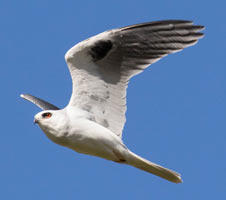 White-tailed Kite: Kites are another bird with a distinctive flight style, hovering (i.e. with active flapping, unlike red-tails which will “still” in the wind) as they look for prey in one spot before taking a quick flight a few dozen yards a way for another hover-and-look. If you see a big, white, hovering bird, it’s probably a kite! While it is true that they have white tails, they are another bird where the old name was in some ways more helpful: “black-shouldered kite” is a name you may see if you have an older bird book, and on a perched bird those black shoulders are very distinctive. You will see them in many of the same places as harriers, as well as in some areas of open oak woodland (unlike ground-nesting harriers, kites do nest in trees, and roost in them outside of the nesting season).
White-tailed Kite: Kites are another bird with a distinctive flight style, hovering (i.e. with active flapping, unlike red-tails which will “still” in the wind) as they look for prey in one spot before taking a quick flight a few dozen yards a way for another hover-and-look. If you see a big, white, hovering bird, it’s probably a kite! While it is true that they have white tails, they are another bird where the old name was in some ways more helpful: “black-shouldered kite” is a name you may see if you have an older bird book, and on a perched bird those black shoulders are very distinctive. You will see them in many of the same places as harriers, as well as in some areas of open oak woodland (unlike ground-nesting harriers, kites do nest in trees, and roost in them outside of the nesting season).
Local photo by Don Bartling.
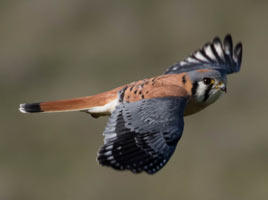 American Kestrel: Our most colorful hawk. The American kestrel is our smallest falcon, and so although they share the pointed wings and general speediness of their relatives, their small size and light weight inclines them a bit towards a rather different hunting and flight style than the bird-catchers like peregrines and merlins. Kestrels often hunt from a perch or hover like kites as they scan the ground for insects and small rodents like mice and voles. Another falcon feature, however, which they show off perhaps best of all, is the distinctive facial “sideburns,” joined in their case by a “mustache” as well, two darker lines which set off the white cheeks, often visible at a distance. Kestrels are, with harriers, the other one of our two hawks that have significant differences between male and female plumage. Males have blue wings and solidly brick red tails, while female wings and tails are reddish-brown with black “tiger stripes.”
American Kestrel: Our most colorful hawk. The American kestrel is our smallest falcon, and so although they share the pointed wings and general speediness of their relatives, their small size and light weight inclines them a bit towards a rather different hunting and flight style than the bird-catchers like peregrines and merlins. Kestrels often hunt from a perch or hover like kites as they scan the ground for insects and small rodents like mice and voles. Another falcon feature, however, which they show off perhaps best of all, is the distinctive facial “sideburns,” joined in their case by a “mustache” as well, two darker lines which set off the white cheeks, often visible at a distance. Kestrels are, with harriers, the other one of our two hawks that have significant differences between male and female plumage. Males have blue wings and solidly brick red tails, while female wings and tails are reddish-brown with black “tiger stripes.”
As another open country hunter, you can see kestrels as well in those areas listed above: Las Gallinas, Rush Creek, Bahia Lagoon, and Deer Island, particularly in winter when they can spread out into those areas near wetlands that have abundant prey though few trees. We have less ideal kestrel nesting habitat than some other parts of the Bay Area (they need big old trees with large cavities for nesting in, but still open hunting areas), but you can find some on Mount Burdell or at Olompali State Historic Park during the summer.
Male kestrel, local photo by Don Bartling
Definitely out there, but take a bit more work to see
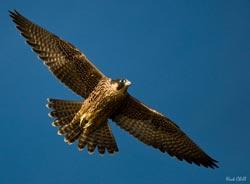 Peregrine Falcon: This famous bird is found in our area, and is relatively widespread in the winter, but does not go chasing after birds in your yard: you’re more likely to see them near bodies of water where they can chase shorebirds, ducks, and gulls. Peregrines feature a dark helmet with "sideburns" and pointed aerodynamic wings which aid their rapid, powerful flight style. They are generally accepted as the fastest animal on earth, with diving speeds over 200 mph. Another of their claims to fame is as one of the greatest success stories of the Endangered Species Act, along with bald eagles and brown pelicans. Devastated by DDT, which caused egg shell thinning and prevented reproduction, peregrine populations in the US were down to a few hundred in the 70s. An extensive re-introduction program combined with the phasing out of DDT has led to a strong resurgence, with thousands of birds now breeding each year.
Peregrine Falcon: This famous bird is found in our area, and is relatively widespread in the winter, but does not go chasing after birds in your yard: you’re more likely to see them near bodies of water where they can chase shorebirds, ducks, and gulls. Peregrines feature a dark helmet with "sideburns" and pointed aerodynamic wings which aid their rapid, powerful flight style. They are generally accepted as the fastest animal on earth, with diving speeds over 200 mph. Another of their claims to fame is as one of the greatest success stories of the Endangered Species Act, along with bald eagles and brown pelicans. Devastated by DDT, which caused egg shell thinning and prevented reproduction, peregrine populations in the US were down to a few hundred in the 70s. An extensive re-introduction program combined with the phasing out of DDT has led to a strong resurgence, with thousands of birds now breeding each year.
Photo by Nick Chill.
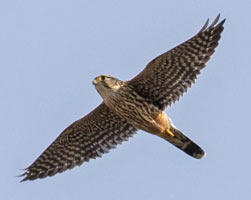 Merlin: The merlin (yes, that’s the full name, a classy one-parter) is another small falcon, just a tiny bit bigger than kestrels. Big time hawkwatcher and bird writer Pete Dunne famously described the relation by saying that “a merlin is to a kestrel what a Harley-Davidson motorcycle is to a scooter,” by which analogy he refers to their flight style, which is generally point-to-point, direct, powerful, and very fast, with none of the hovering or casual buoyancy of kestrels.
Merlin: The merlin (yes, that’s the full name, a classy one-parter) is another small falcon, just a tiny bit bigger than kestrels. Big time hawkwatcher and bird writer Pete Dunne famously described the relation by saying that “a merlin is to a kestrel what a Harley-Davidson motorcycle is to a scooter,” by which analogy he refers to their flight style, which is generally point-to-point, direct, powerful, and very fast, with none of the hovering or casual buoyancy of kestrels.
Plumage wise, they are perhaps less distinctive than the other falcons listed here, with facial markings limited to a faint eyebrow. If you're not familiar with them, you could confuse perched birds at a distance with similarly-sized sharp-shinned hawks, another small light brown raptor, but look for merlins' dark tails with thin light bands (sharp-shins have broad dark brown/light brown bands) and dark eyes (sharp-shins are yellow or red, depending on age). And see if they shoot into the air to harass innocent avian passers-by or vanish in the distance like a rocket. Both behaviors suggest merlin. Merlins feed on a variety of prey, including both small songbirds and small shorebirds: around here they also like open areas near wetlands, such as at Hamilton, Las Gallinas, or Shollenberger/Ellis Creek.
Local photo by Don Bartling.
 Bald Eagle: Although not common in Marin, bald eagles are still worth noting because, hey, they’re bald eagles! Birds have bred for several years at Kent Lake on the north side of Mount Tamalpais and are increasingly colonizing the Bay Area as breeding birds. In winter, northern birds come down here and spend time near bodies of water and can sometimes be seen in Northeast Marin at Stafford Lake or in the general vicinity of the Petaluma River wetalnds, or near bodies of water around the county such as Tomales Bay, Nicasio Reservoir, or Bolinas Lagoon. If you’re anywhere near water in winter, in other words, it is possible to see a huge dark bird with a white head and tail flying overhead. Keep your eyes open!
Bald Eagle: Although not common in Marin, bald eagles are still worth noting because, hey, they’re bald eagles! Birds have bred for several years at Kent Lake on the north side of Mount Tamalpais and are increasingly colonizing the Bay Area as breeding birds. In winter, northern birds come down here and spend time near bodies of water and can sometimes be seen in Northeast Marin at Stafford Lake or in the general vicinity of the Petaluma River wetalnds, or near bodies of water around the county such as Tomales Bay, Nicasio Reservoir, or Bolinas Lagoon. If you’re anywhere near water in winter, in other words, it is possible to see a huge dark bird with a white head and tail flying overhead. Keep your eyes open!
Local photo by Don Bartling.
Did you see Part 1 of this article, covering the most common backyard hawks of the Bay Area?

